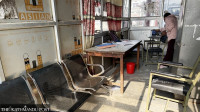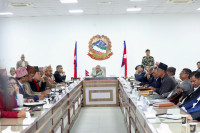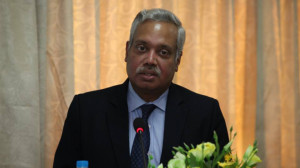National
Nepal puts 17,000 security personnel on standby for monsoon response
Command centres set up at all tiers of government. But officials say resource crunch may affect disaster risk reduction.
Post Report
The government is set to mobilize more than 17,000 security personnel for responding to monsoon-related disasters, in addition to the Nepali Army, which is also on standby, officials at the Ministry of Home Affairs said on Tuesday.
The National Disaster Risk Reduction and Management Authority (NDRRMA) shared this information at a press conference held at Singha Durbar. Poor response from the government in the past has resulted in the loss of lives, destruction of private and public property, and damage to infrastructure.
Earthquakes, landslides, floods, fires, and lightning strikes have been the major causes of disasters in Nepal as they have caused significant loss of life, damage to private and public property, and other destruction. Nepal suffers greatly during the monsoon season due to landslides and floods triggered by the rainfall.
The monsoon usually enters Nepal around June 13 and lasts until September 23. This year, however, the Met Department has forecast above-normal monsoon rainfall. The rains may improve crop yields and offer a much-needed boost for the country’s struggling economy. At the same time, the risk of flash floods and landslides is likely to rise.
Ram Bahadur KC, spokesperson at NDRRMA, said that 10,085 personnel from the Nepal Police and 7,615 from the Armed Police Force are on standby for monsoon-related disaster mitigation, relief, and rescue operations. He also added that the Nepali Army has made similar preparations, with personnel and equipment ready for deployment.
Home Minister Ramesh Lekhak visited the headquarters of the Armed Police Force and Nepal Police on Tuesday and took stock of the preparedness of both security agencies. According to meteorologists, the monsoon has arrived in Nepal one week earlier than expected.
NDRRMA spokesman KC, meanwhile, admitted that limited resources could hinder comprehensive disaster risk reduction efforts. He said past experiences have shown that security agencies often face difficulties during rescue and search operations due to a lack of equipment, technology and manpower.
To improve coordination, the government has formed a Monsoon Response Command Post, an integrated command comprising all security agencies, to deal with both pre- and post-disaster scenarios. However, the command post is not yet operational.
The home administration faced sharp criticism last year after security agencies failed to rescue some people stranded in the middle of a swollen Bagmati River in Lalitpur.
KC added that in previous years, the responsibilities of the monsoon response command post were not clearly defined. This year, those roles have been clarified. The command post will be established not only at the federal level, but also provincial, district, and local levels.
According to the disaster management authority, Nepal has experienced 8,418 disaster-related incidents over the past 10 years, resulting in 2,317 deaths. Additionally, 419 people went missing, and 2,649 were injured.
Last year’s monsoon brought the heaviest rainfall in 77 years. Between Ashwin 10 and 13, 2080 (September 27–30, 2023), alone, 250 people lost their lives and property damage worth Rs45 billion were reported. In the year 2080 BS (2023-24), there were 2,138 disaster-related incidents that caused 495 deaths and left 66 people missing.
The NDRRMA has predicted that around two million people could be affected by monsoon-related disasters this year. According to the projection, the districts of Lumbini province will be affected the most in the monsoon—5,23,656 people from 119,830 households will be affected. This is followed by the Bagmati—327, 376 people from 74,914 households, Gandaki—287,107 people from 65,699 households, Koshi 275,867 people from 63,127 households, Madhesh—228,687 people from 52,331 households, Sudurpaschim—227,730 people from 52,112 households, and Karnali province—127,308 people from 29,132 households.




 19.12°C Kathmandu
19.12°C Kathmandu














